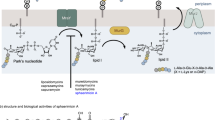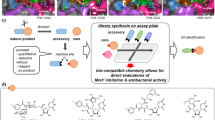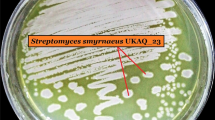Abstract
We screened for bacterial phospho-N-acetylmuramyl-pentapeptide-translocase (MraY: EC 2.7.8.13) inhibitors with the aim of discovering novel antibiotics and observed inhibitory activity in the culture broth of an actinomycete, SANK 60501. The active compounds, muraminomicins A, B, C, D, E1, E2, F, G, H, and I exhibited strong inhibitory activity against MraY with IC50 values of 0.0105, 0.0068, 0.0104, 0.0099, 0.0115, 0.0109, 0.0089, 0.0134, 0.0186, and 0.0094 μg ml−1, respectively. Although muraminomicin F exhibited favorable antibacterial activity against drug-resistant Gram-positive bacteria, this activity was reduced with the addition of serum. To efficiently supply the core component for chemical modification studies, production was carried out in a controlled trial by adding myristic acid to the medium, and a purification method suitable for large-scale production was successfully developed.
Similar content being viewed by others
Log in or create a free account to read this content
Gain free access to this article, as well as selected content from this journal and more on nature.com
or
References
Fleming A. On the antibacterial action of cultures of a Penicillium, with special reference to their use in the isolation of B. influenzae. Br J Exp Pathol. 1929;10:226–36.
The evolving threat of antimicrobial resistance: options for action. Geneva, Switzerland: World Health Organization; 2012. ISBN: 9789241503181.
Butler MS, Blakovich MA, Cooper MA. Antibiotics in the clinical pipeline in 2013. J Antibiot. 2013;66:571–91.
Brandish PE, et al. Modes of action of tunicamycin, liposidomysin B and mureidomycin A: inhibition of phospho-N-acetylmuramyl-pentapeptide translocase from Escherichia coli. Antimicrob Agents Chemother. 1996;40:1640–4.
Ubukata M, Isosno K. The structure of liposidomycin B, an inhibitor of bacterial peptidoglycan synthesis. J Am Chem Soc. 1988;110:4416–7.
Igarashi M, et al. Caprazamycin B, a novel anti-tuberculosis antibiotic, from Streptomyces sp. J Antibiot. 2003;56:580–3.
Igarashi M, et al. Caprazamycins, novel lipo-nucleoside antibiotics, from Streptomyces sp. II. Structure elucidation of caprazamycins. J Antibiot. 2005;58:327–37.
Inukai M, et al. Mureidomycin A-D, novel peptidylnucleoside antibiotics with spheroplast forming activity. I. Taxonomy, fermentation, isolation and physico-chemical properties. J Antibiot. 1989;42:662–6.
Karwowski JP, et al. Pacidamycins, a novel series of antibiotics with anti-Pseudomonas aeruginosa activity. I. Taxonomy of the producing organism and fermentation. J Antibiot. 1989;42:506–11.
Chatterjee S, et al. Naspamycins new Pseudomonas active antibiotics of the mureidomycin family from Streptomyces sp. HIL Y-82, 11372. J Antibiot. 1994;47:595–8.
Yamaguchi H, et al. Capuramycin, a new nucleoside antibiotic. Taxonomy, fermentation, isolation and characterization. J Antibiot. 1986;39:1047–53.
Seto H, Otake N. The structure of a new nucleoside antibiotic, capuramycin. Tetrahedron Lett. 1988;29:2343–6.
Muramatsu Y, et al. Studies on novel bacterial translocase I inhibitors, A-500359s. I Taxonomy, fermentation, isolation, physico-chemical properties and structure elucidation of A-500359 A, C, D and G. J Antibiot. 2003;56:243–52.
Muramatsu Y, Ishii MM, Inukai M. Studies on novel bacterial translocase I inhibitors, A-500359s. II. Biological activities of A-500359 A, C, D and G. J Antibiot. 2003;56:253–8.
McDonald LA, et al. Structures of the muraymycins, novel peptidoglycan biosynthesis inhibitors. J Am Chem Soc. 2002;124:10260–1.
Murakami R, et al. A-102395, a new inhibitor of bacterial translocase I, produced by Amycolatopsis sp. SANK 60206. J Antibiot. 2007;60:690–5.
Murakami R, et al. A-94964, a novel inhibitor of bacterial translocase I, produced by Streptomyces sp. SANK 60404. I. Taxonomy, isolation and biological activity. J Antibiot. 2008;61:537–44.
Fujita Y, Murakami R, Muramatsu Y, Miyakoshi S, Takatsu T. A-94964, novel inhibitor of bacterial translocase I, produced by Streptomyces sp. SANK 60404. II. Physico-chemical properties and structure elucidation. J Antibiot. 2008;61:545–9.
Fujita Y, et al. A-90289 A and B, new inhibitors of bacterial translocase I, produced by Streptomyces sp. SANK 60405. J Antibiot. 2011;64:495–501.
Muramatsu Y, et al. New antibiotic muraminomicin. Jpn Kokai Tokkyo Koho. 2004;JP2004-196780.
Knapp S, et al. Assignment of the liposidomycin diazepanone stereochemistry. J Org Chem. 2001;66:5822–31.
Hirano S, Ichikawa S, Matsuda A. Total synthesis of caprazol, a core structure of the caprazamycin antituberculosis antibiotics. Angew Chem Int Ed. 2005;44:1854–6.
Gopinath P, et al. Catalytic asymmetric total synthesis of (+)-caprazol. Org Lett. 2014;16:3364–7.
Igarashi M, Takeuchi T, Naganawa H, Hamada M. Antibiotic caprazamycins and process for producing the same. 2001; WO/2001/012643.
vKimura K, Ikeda Y, Kagami M, Yoshihama M. Selective inhibition of the bacterial peptidoglycan biosynthesis by the new type of liposidomycins. J Antibiot. 1998;51:1099–104.
Takahashi Y, et al. Novel semisynthetic antibiotics from caprazamycins A-G: caprazene derivatives and their antibacterial activity. J Antiobiot. 2013;66:171–8.
Ishizaki Y, et al. Inhibition of the first step in synthesis of the mycobacterial cell wall core, catalyzed by the GlcNAc-1-phosphate transferase WecA, by the novel caprazamycin derivative CPZEN-45. J Biol Chem. 2013;42:30309–19.
Chi X, et al. The muraminomicin biosynthetic gene cluster and enzymatic formation of the 2-deoxyaminoribosyl appendage. Med Chem Commun. 2013;4:239–43.
Clinical and Laboratory Standard Institute. Methods for dilution antimicrobial susceptibility tests for bacteria that grow aerobically. 9th ed. Approved Standard M07-A09. Wayne, PA, USA: CLSI; 2012.
Author information
Authors and Affiliations
Corresponding author
Ethics declarations
Conflict of interest
There is no conflict of interest from this paper publishment.
Additional information
Publisher’s note: Springer Nature remains neutral with regard to jurisdictional claims in published maps and institutional affiliations.
Dedicated with respect to Professor K. Isono’s long-standing and outstanding contribution to the isolation, structural determination, and mechanism of action of natural products, particularly nucleic acid antibiotics.
Supplementary information
Rights and permissions
About this article
Cite this article
Fujita, Y., Kagoshima, Y., Masuda, T. et al. Muraminomicins, new lipo-nucleoside antibiotics from Streptosporangium sp. SANK 60501-structure elucidations of muraminomicins and supply of the core component for derivatization. J Antibiot 72, 943–955 (2019). https://doi.org/10.1038/s41429-019-0215-7
Received:
Revised:
Accepted:
Published:
Issue date:
DOI: https://doi.org/10.1038/s41429-019-0215-7
This article is cited by
-
β-Hydroxylation of α-amino-β-hydroxylbutanoyl-glycyluridine catalyzed by a nonheme hydroxylase ensures the maturation of caprazamycin
Communications Chemistry (2022)
-
Liposidomycin, the first reported nucleoside antibiotic inhibitor of peptidoglycan biosynthesis translocase I: The discovery of liposidomycin and related compounds with a perspective on their application to new antibiotics
The Journal of Antibiotics (2019)
-
Muraminomicins, novel ester derivatives: in vitro and in vivo antistaphylococcal activity
The Journal of Antibiotics (2019)



